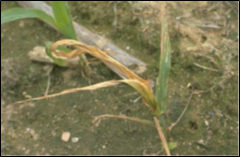Anthracnose in Corn
Anthracnose
Symptoms
Anthracnose, caused by the fungus Colletotrichum graminicola, is often the first disease that shows up on corn.

Anthracnose on corn.
Small, round to irregular, water-soaked spots first appear on lower leaves. Spots later turn yellow and then brown with reddish-brown borders. Yellow zones often develop around the leaf spots (see figure at right). Numerous spots can cause leaf tips or entire leaves to turn yellow. With the aid of a hand lens, black spines can be seen arising from the center of the spots. The leaf-spotting phase of the disease generally doesn't occur past the knee-high stage of corn growth.
Cause
The fungal pathogen Colletotrichum graminicola is the causal agent of anthracnose in corn. Anthracnose is common early in the season in fields where debris from the previous year was left on the soil. This early season disease phase is generally more severe in fields where continuous no-till corn has been grown. It causes a leaf spot disease when corn is in the seedling stage. The pathogen is disseminated by wind and rain splash.
Plants become somewhat resistant to the leaf-spotting phase as the crop develops. If weather conditions are favorable for continued development of the disease (high moisture and moderate temperatures), plants become susceptible to the "top-dieback" and stalk rot disease phases later in the season.
Detection of anthracnose at the seedling stage should alert scouts to watch for the disease later in the season. The fungus also affects a number of grass species. The presence of infected grasses in or near corn fields could represent a continuing source of new infection.
IPM Techniques
- Observations should be made every three weeks when plants are between the knee-high and whorl stages. Observe two rows of plants 10 feet in length at several representative locations. Report severity of the disease according to the following rating scale:
0 = no anthracnose
1 = lower most leaf contains some yellow anthracnose lesions
2 = lower most leaf yellowed and dried up, anthracnose lesions found on second and third leaves
3 = second and third leaves dried up and anthracnose found on highest leaves
- Plant resistant hybrids and varieties, especially in no-till fields. Resistance to seedling leaf blight does not guarantee resistance to anthracnose stalk rot.
- A balanced soil fertility will help plants resist infection.
- Rotate away from corn for one to two years, especially in no-till fields.
References and Additional Information
- IPM-2 Kentucky IPM Manual for Corn
- PPA-10a Kentucky Plant Disease Management Guide for Corn and Sorghum, P. Vincelli and D.E. Hershman, Extension Plant Pathology, University of Kentucky
Compendium of Corn Diseases.M.C. Shurtleff. The Amer. Phytopathol. Soc. 1980.


